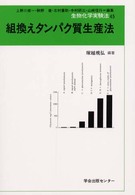- ホーム
- > 洋書
- > 英文書
- > Computer / General
Full Description
The book is essential for anyone seeking to understand and leverage the transformative power of intelligent automation technologies, providing crucial insights into current trends, challenges, and effective solutions that can significantly enhance operational efficiency and decision-making within organizations.
Intelligent automation systems, also called cognitive automation, use automation technologies such as artificial intelligence, business process management, and robotic process automation, to streamline and scale decision-making across organizations. Intelligent automation simplifies processes, frees up resources, improves operational efficiencies, and has a variety of applications. Intelligent automation systems aim to reduce costs by augmenting the workforce and improving productivity and accuracy through consistent processes and approaches, which enhance quality, improve customer experience, and address compliance and regulations with confidence. Handbook of Intelligent Automation Systems Using Computer Vision and Artificial Intelligence explores the significant role, current trends, challenges, and potential solutions to existing challenges in the field of intelligent automation systems, making it an invaluable guide for researchers, industry professionals, and students looking to apply these innovative technologies.
Readers will find the volume:
Offers comprehensive coverage on intelligent automation systems using computer vision and AI, covering everything from foundational concepts to real-world applications and ethical considerations;
Provides actionable knowledge with case studies and best practices for intelligent automation systems, computer vision, and AI;
Explores the integration of various techniques, including facial recognition, natural language processing, neuroscience and neuromarketing.
Audience
The book is designed for AI and data scientists, software developers and engineers in industry and academia, as well as business leaders and entrepreneurs who are interested in the applications of intelligent automation systems.
Contents
Preface xix
1 Toward a Smarter Future: The Role of AI in Transforming Automation Systems 1
Manish Kumar Singla, Rupali Gill, Ramesh Kumar, Jyoti Gupta and Gaurav Sharma
1.1 Introduction 1
1.2 The Power of AI in IAS 3
1.3 Transforming Automation: A Multifaceted Impact 4
1.4 Benefits and Impact of IAS 6
1.5 The Spectrum of Applications: From Manufacturing to Beyond 7
1.6 Challenges and Considerations 8
1.7 Strategies for Mitigating Negative Impacts 10
1.8 Ethical Considerations of IAS 11
1.9 Discussion 12
1.10 Conclusion 13
References 14
2 Industry 5.0: Mapping the Lens from Know How to Realization 17
Upinder Kumar, Mahender Singh Kaswan and Rakesh Kumar
2.1 Introduction 17
2.2 Basic Principles of Industry 5.0 19
2.3 Technologies and Their Roles in Industry 5.0 20
2.4 Operator 5.0 31
2.5 Education 5.0 33
2.6 Industry 5.0 and Sustainability 36
2.7 Conclusion 37
References 38
3 Intelligent Automation System Integration in Mobile and Industrial Robotics for Enhanced Performance and Efficiency 47
Abdullah Bin Queyam, Ramesh Kumar, Anupma Gupta and Vipin Kumar
3.1 Introduction 47
3.2 Industrial Robotics 49
3.3 Anthropomorphic Robot: Bridging the Gap Between Humans and Machines 49
3.4 Case Study 54
3.5 Conclusion 72
References 72
4 Automation of Data Flow Management Based on Artificial Intelligence in Systems with an Internal Distribution Mechanism 75
A.E. Rashidov, A.R. Akhatov, F.M. Nazarov and I.N. Turakulov
4.1 Introduction 75
4.2 Methodology 83
4.3 Results 93
4.4 Discussion 96
4.5 Conclusion 97
References 97
5 Robotic Process Automation (RPA) and Virtual Reality Implementation in Engineering Education 103
Jabar H. Yousif , Ahmad Kayed and Maryam G. Aljabri
5.1 Introduction 103
5.2 Ethical Factors 105
5.3 Research Design 106
5.4 Research Questions 107
5.5 Experimental Design 108
5.6 Results and Discussion 110
5.7 Conclusion 115
References 116
6 Ethical Issues of Intelligent Automation Systems 119
V. Punitha, R. Sivanesan, P. Sharmila and G. Nithyakala
6.1 Introduction 119
6.2 Intelligent Automation Systems 123
6.3 The Ethical Implications of Intelligent Automation Systems 127
6.4 Case Studies of Ethical Issues in IAS Decision-Making 135
6.5 Environmental Impacts of IAS 139
6.6 Existing Ethical Frameworks of IAS 140
6.7 Conclusion 141
References 141
7 IAS and Facial Recognition System 145
Ritu, Yogesh Shahare, Dinesh Singh Dhakar and Ritu Jain
7.1 Introduction 145
7.2 Literature Review 146
7.3 Understanding Intelligent Automation Systems (IASs) 148
7.4 Advancements in Facial Recognition Technology 150
7.5 Integration with Intelligent Automation Systems 153
7.6 Challenges and Limitations 155
7.7 Future Prospects and Emerging Trends 157
7.8 Security and Surveillance Applications 158
7.9 Ethical and Societal Implications 159
7.10 Conclusion 160
References 161
8 An Image Synthesis Using Progressive Generative Adversarial Networks (PGANs) 163
Ajay Pal Singh, Parvez Rahi and Vinod Kumar
8.1 Introduction 163
8.2 How Does GAN Work? 165
8.3 The Birth of GANs: Recognizing the Need for Adversarial Frameworks 167
8.4 Proposed Solutions 168
8.5 Deep Learning Structures 172
8.6 Analysis and Feature Finalization Subject to Constraints 173
8.7 Design Flow 174
8.8 The Comprehensive Design Flows 176
8.9 Principal Results 178
8.10 Training Stability 179
8.11 GAN Applications 180
8.12 Conclusion 181
References 181
9 Future Direction in Sign Language Recognition: A Review 185
Nidhi Goel, Lekha Rani and Pradeepta Kumar Sarangi
9.1 Introduction 185
9.2 Sign Languages Around the World 187
9.3 Sign Language Linguistics 192
9.4 Motivation 193
9.5 Objective 193
9.6 Related Work 194
9.7 Approaches 196
9.8 Proposed Methodology 198
9.9 Conclusion and Future Scope 200
References 201
10 Understanding Computer Vision for Intelligent Autonomous Systems 203
Summiya Parveen and Aruna Tomar
10.1 Introduction 203
10.2 Fundamentals of Computer Vision 205
10.3 Applications of Computer Vision in IAS 210
10.4 Challenges and Emerging Techniques 217
10.5 Future Directions and Conclusion 221
References 222
11 Computer Vision and Artificial Intelligence for Intelligence Automation Systems (IAS) 227
Dharmendra Dangi, Vaibhav Suman, Amit Bhagat and Dheeraj Kumar Dixit
11.1 Introduction 227
11.2 Artificial Intelligence 229
11.3 Computer Vision 237
11.4 Conclusion 242
11.5 Future Scope 243
References 243
12 Neural Network Approaches for Intelligent Decision-Making in Automation 247
S.Z. Rufai, Inam Ul Haq, H.A. Shah and Mir Abrar Fayaz
12.1 Introduction 247
12.2 Role of Neural Networks in Modern Automation 248
12.3 Fundamental Principles of Neural Networks 249
12.4 Neural Network Architectures in Automation Systems 256
12.5 Comparative Analysis of Different Architectures 261
12.6 Neural Network Applications in Automation 263
12.7 Training Strategies for Neural Networks 266
12.8 Practical Considerations for Deployment 270
12.9 Conclusion 273
References 273
13 A Novel Approach for Object Detection Technique Using Deep Learning 277
Kumud Sachdeva and Rajan Sachdeva
13.1 Introduction 278
13.2 Literature Survey 279
13.3 Deep Learning Methods 281
13.4 Deep Learning Models 284
13.5 Experimental Results 287
13.6 Conclusion and Future Scope 289
Bibliography 290
14 Role of AI in Mental Health Care 295
Kala K.U., Prabhakaran Mathialagan, Solomon Jebaraj N.R. and Sambath Kumar S.
14.1 Introduction 295
14.2 Significance of Addressing Mental Health Challenges 296
14.3 Prevalent Mental Health Disorders 298
14.4 Impact of Mental Health on Physical Well-Being 299
14.5 The Societal Implications of Mental Health Disorders 300
14.6 Significance of Early Recognition of Mental Health Matters 302
14.7 Strategies for the Early Recognition of Mental Health Challenges 303
14.8 Role of Technology in Mental Health Care 304
14.9 AI in Mental Health Care 305
14.10 AI in Screening and Assessment of Mental Health Issues 306
14.11 AI in Personalized Treatment Planning 307
14.12 AI in Digital Therapeutic Interventions 310
14.13 AI Chatbot's and Virtual Assistants in Mental Health Care 313
14.14 Data Analysis and Predictive Modeling in Mental Health Care 315
14.15 AI in Mental Health Monitoring 317
14.16 Conclusion and Future Work 320
References 321
15 Application Areas of Computer Vision and AI in Intelligent Automation Systems 327
Vinod Kumar, Chander Prabha, Ajay Pal Singh and Raj Kumar
15.1 Introduction 327
15.2 Advanced Techniques in CV and AI for IAS 328
15.3 Why We Use AI in Research and Services Today 331
15.4 The Association Across AI, ML, and dl 332
15.5 Exploring Deep Learning and Neural Systems 333
15.6 Delving into Deep Neural Networks' Learning Approaches 334
15.7 Rule-Based Modeling: A Cornerstone of AI Development 336
15.8 The Role of Fuzzy Logic and Distributed Logic in AI 337
15.9 AI and CV Technologies for Advancing Manufacturing Industries 338
15.10 AI and CV Revolutionizing Healthcare Innovations 338
15.11 Innovative Solutions for Agriculture and Environment 340
15.12 Innovative Solutions for Retail and Consumer Goods 341
15.13 Revolutionizing Transportation and Logistics with AI and cv 342
15.14 Advancing AI through Case-Based Reasoning (CBR) 345
15.15 Text Mining and NLP in IAS 346
15.16 Exploring Artificial Intelligence Applications and Challenges 360
15.17 Exploring Artificial Intelligence in Computer Vision Tasks 360
15.18 Conclusion 362
References 362
16 A Real-Time Speech-Text Conversion System Using Deep Learning Technique 371
K. Saranya and P. Jeevananthan
16.1 Introduction 371
16.2 Related Works 373
16.3 Problem Definition 375
16.4 System Specification 375
16.5 Methodology and Flowchart 378
16.6 Audio Conversion 380
16.7 Results and Discussion 384
16.8 Conclusion 386
References 387
17 Transforming the Evaluation: The Crucial Role of Natural Language Processing in Intelligent Automation System 389
Pratibha, Bhavna Sharma, Sana Bharti, Susheela Hooda and Shilpi Harnal
17.1 Introduction 389
17.2 Natural Language Processing (NLP) as the Foundation of Intelligent Automation 396
17.3 Exploring Current Applications 397
17.4 Future Directions for NLP in an Automated Environment 399
17.5 Challenges and Opportunities 402
17.6 Developing Talent: Cultivating Natural Language Processing Masters of Tomorrow 404
17.7 Conclusion and Future Scope 404
References 404
18 IAS and Its Impact in Neuroscience 407
G. Vijaya and K. Ramesh
18.1 Introduction 407
18.2 Neuroscience 411
18.3 Integration of Neuroscience with Intelligent Automation Systems (IAS) 412
18.4 Challenges in Integrating IAS in Neuroscience Applications 414
18.5 Application Areas of Neuroscience in Intelligent Automation Systems 415
18.6 Conclusion 419
References 419
19 Intelligent Automation Systems (IAS) and Its Application in Neuroscience 423
Bikram Kar and Amit Kumar
19.1 Introduction 423
19.2 Understanding Neurosciences 430
19.3 How Neuroscience Can Help in Understanding Intelligent Automation Systems (IAS) 434
19.4 Application Areas of Neuroscience in IAS 437
19.5 Connecting IAS and Neuroscience 440
19.6 Challenges and Future Directions 443
19.7 Conclusion 445
References 446
20 A Neuromarketing Framework for Data-Driven Intelligent Automation in Marketing 449
Jyoti Kesarwani, Himanshu Rai and Rahul Kesarwani
20.1 Introduction 449
20.2 Literature Review 451
20.3 Proposed Neuromarketing Framework 457
20.4 Benefits and Applications of Neuromarketing 460
20.5 Real-Time Campaign Optimization Using Biometric Feedback 462
20.6 Mitigating Bias in AI Through Neuromarketing Data 464
20.7 Other Potential Applications 465
20.8 Conclusion 466
References 467
21 Neuroscience and Intelligent Automation System 471
Harpreet Kaur and Pannem Shreya
21.1 Introduction 471
21.2 Intelligent Automation 473
21.3 Technologies and Software Associated with IA Systems 474
21.4 History of Developments in AI and Neuroscience 476
21.5 Essential Technologies for Developing IAS 476
21.6 Discoveries Related to Neuroscience 477
21.7 Applications of Artificial Intelligence in Neuroscience 478
21.8 Artificial Neural Network Versus Biological Neural Network 480
21.9 Developments of Intelligent Automation Systems Models 481
21.10 AI for Neuroscience Development 484
21.11 Neuromarketing 487
21.12 AI Inspired by Brain Science 488
21.13 Current State 489
21.14 Conclusion 490
References 490
22 Unveiling the Visual World Through AI-Powered Computer Vision 493
Sonia Kumari Shishodia, Shuchi Sharma, Eram Khan and Logesh Babu
22.1 Introduction 493
22.2 The Human Eye Anatomy 494
22.3 Key Techniques 503
22.4 Applications of AI-Powered Computer Vision Across Industries 504
22.5 Threat Detection and Monitoring in Surveillance and Security 506
22.6 Trends and Future Directions in AI-Powered Computer Vision 506
22.7 Conclusion 507
References 507
Index 511








